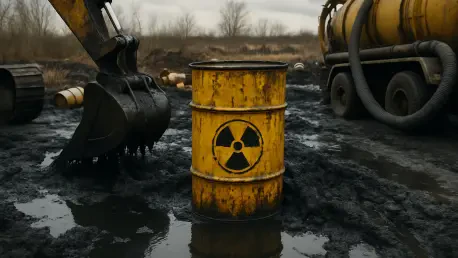In a world grappling with the lingering challenges of nuclear legacy, a facility in South Carolina stands as a beacon of progress in tackling one of the most daunting environmental issues: radioactive waste. The Savannah River Site (SRS), managed by the U.S. Department of Energy (DOE), has recently marked a significant achievement in its mission to remediate high-level liquid waste from the Cold War era. This milestone not only highlights a remarkable acceleration in cleanup efforts but also showcases a model of collaboration and innovation that could inspire global nuclear waste management strategies. As environmental concerns continue to mount, the work at SRS offers a glimpse into how dedication and efficiency can transform a decades-old problem into a story of success, ensuring safer communities and ecosystems for future generations.
Milestones in Waste Management
Accelerating Tank Closures
The recent news of Tank 8 achieving preliminary cease waste removal (PCWR) approval at the Savannah River Site underscores an extraordinary pace in environmental cleanup. This tank, the sixth to reach this regulatory milestone in just over a year, was completed more than 12 months ahead of its projected timeline. Managed by the DOE’s Office of Environmental Management (EM), this achievement reflects a broader trend of surpassing expectations in handling millions of gallons of radioactive waste stored in underground tanks. The significance lies not just in the numbers but in the implications for environmental safety, as each closure reduces the risk of contamination to surrounding areas. Collaboration between EM and its liquid waste contractor, Savannah River Mission Completion (SRMC), has proven instrumental in driving this progress, setting a benchmark for efficiency in a field often slowed by technical and regulatory complexities.
Beyond the completion of Tank 8, the pattern of early successes at SRS paints a picture of consistent dedication to environmental remediation. Tanks 4, 9, 10, 11, and 15 have also secured PCWR status, with completion dates ranging from seven to 19 months ahead of schedule. This accelerated timeline is a testament to the innovative waste management practices employed by SRMC, which prioritize both speed and safety. Regulatory bodies, including the U.S. Environmental Protection Agency (EPA) and the South Carolina Department of Environmental Services, have expressed confidence in these efforts, noting that performance objectives for tank closures are being met with precision. The next steps involve detailed sampling and analysis to confirm residual waste levels before permanent sealing with grout, ensuring that no environmental risks remain. This rigorous process highlights the balance between rapid progress and meticulous care in nuclear waste cleanup.
Significance of PCWR Approvals
Achieving PCWR approval is a critical step in the journey toward permanent tank closure at SRS, signaling a preliminary consensus among stakeholders that cleanup goals are on track. For Tank 8 and its counterparts, this milestone indicates that the bulk of radioactive waste has been safely removed, paving the way for final assessments. The process is far from superficial; it involves close collaboration with regulatory authorities to ensure compliance with strict environmental standards. Statements from key figures, such as EM’s leadership, emphasize that protecting people and the environment remains the top priority, even as timelines are shortened. This balance of urgency and caution is what makes the SRS approach a potential model for other nuclear facilities worldwide facing similar challenges.
The impact of these approvals extends beyond technical achievements to broader environmental and community benefits. Each tank closure at SRS reduces the long-term risks associated with storing high-level waste, safeguarding local ecosystems and water resources. The collaborative framework under the SRS Federal Facility Agreement has been pivotal in aligning the efforts of multiple agencies toward common goals. Regulatory praise for exceeding commitments, particularly those outlined in recent high-level waste agreements, underscores the trust built through transparent and effective operations. As SRMC continues to demonstrate expertise in waste treatment and disposal, the site’s reputation as a leader in nuclear cleanup grows, offering valuable lessons in managing complex environmental legacies with accountability and foresight.
Collaboration and Future Outlook
Strength in Partnerships
The success at SRS is not a solitary endeavor but a result of robust partnerships among various entities committed to environmental stewardship. The synergy between the DOE’s Office of Environmental Management, SRMC, the EPA, and state regulatory bodies has created a streamlined process for waste removal and tank closure. This collaborative spirit is evident in the shared optimism about the pace of progress, with stakeholders consistently highlighting the importance of safety alongside efficiency. The procedural frameworks established by agreements like the SRS Federal Facility Agreement provide clear schedules and accountability measures, ensuring that milestones are not just met but often exceeded. Such teamwork serves as a powerful example of how inter-agency cooperation can address some of the most pressing environmental challenges.
Looking deeper into this collaboration, the role of SRMC as the liquid waste contractor cannot be overstated in driving operational excellence at SRS. The organization’s ability to implement safe and effective waste treatment methods has been lauded by regulatory partners, positioning it as an international benchmark for nuclear cleanup. Comments from industry leaders reflect pride in these accomplishments, noting that the accelerated closures are a direct result of innovative practices and a steadfast commitment to environmental protection. As more tanks approach PCWR status, the lessons learned from these partnerships could inform future projects, both at SRS and beyond. The emphasis on maintaining rigorous safety standards, even under tight schedules, ensures that progress does not come at the expense of quality or community well-being.
Building on Past Successes
Reflecting on the journey so far, the strides made at SRS in securing PCWR approvals for multiple tanks showcase a remarkable chapter in nuclear waste remediation history. The early completion of these milestones, often months ahead of schedule, speaks to the dedication and expertise that define the site’s operations in recent years. Each tank closure represents a step closer to mitigating the environmental risks tied to Cold War-era waste, with safety as the unwavering priority. The collaborative efforts that fueled these achievements leave a legacy of trust and efficiency, proving that complex challenges can be met with determination and strategic planning.
Moving forward, the focus at SRS should center on sustaining this momentum by leveraging the proven strategies of collaboration and innovation. Expanding the scope of tank closures while maintaining stringent safety protocols will be crucial in addressing the remaining waste challenges. Additionally, sharing insights and best practices with other nuclear facilities could amplify the impact of these efforts on a global scale. Investing in advanced technologies for waste treatment and disposal may further enhance efficiency, ensuring that future milestones are achieved with the same precision. As the site continues to lead by example, the path ahead lies in building on these past successes to create a safer, cleaner environment for all.









